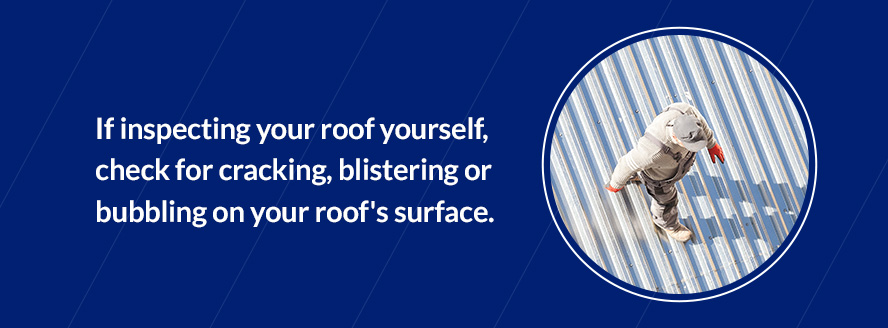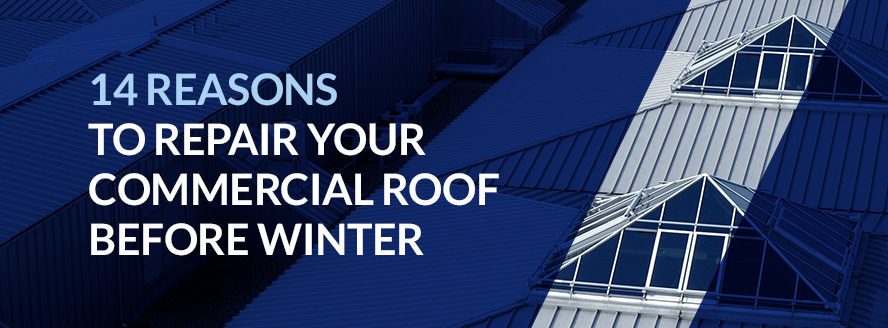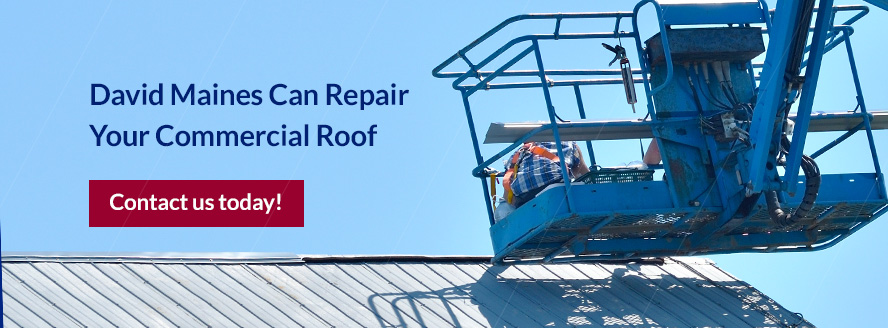Keeping the roof of your business in top condition is critical for the success of your company. The best time to perform these repairs is before winter arrives. In this article, we’ll go over the most common signs that your roof needs repairs before the arrival of the coldest season of the year.
1. Your Energy Bills Have Increased Significantly
If you’ve noticed that your utility bills have gone up even though you haven’t made any changes in your consumption habits, your roof may be to blame. While many business owners don’t think to attribute energy spikes to roofing problems, the roof plays an important role in regulating interior temperatures.
A roof provides insulation, keeping heat inside when the weather is cold and keeping it outside when the weather is hot. If your roof insulation is old or contains lots of moisture due to roof damage, the HVAC system must exert itself more to keep temperatures comfortable in your building.
2. Moisture in Your Building
One telltale sign of roof damage is a water leak in your building. If water is dripping from the ceiling or down the walls when it’s raining, this leakage indicates a roof issue.
As a roof serves to safeguard everything inside your commercial building from natural elements like rain and snow, it must be waterproof and watertight for maximum protection. If your roof has lost these qualities due to wear, damage or simply age, you need to repair it right away. Once moisture makes its way inside your building, the building’s entire structure will be weakened.
Leaks also create an environment where mold and mildew can grow and thrive. If you notice a damp odor in your business, there’s a decent chance that you’re smelling moisture coming in through the roof.
Other signs of moisture include stains on the ceilings and walls. If you notice either of these signs, check the roof and your pipes. If you find that the problem is widespread throughout your building, you may be due for a roof replacement.
3. Ponding Water on a Flat Roof
Even if water doesn’t make its way into your building, you’ll still need to ensure it doesn’t collect on your roof and cause damage. Water should drain off or evaporate off of a roof within a day or two — if this doesn’t happen, it’s a cause for concern.
Standing water is a serious problem because it often leads to roof leaks and mold growth. These two issues can accelerate your roof’s deterioration, especially if your roof is made of rubber or asphalt.
If you have ponding issues on your commercial roof, talk to an expert who specializes in repairing commercial flat roofs. While a certain amount of pooling water is normal on a flat roof, it should go away quickly after rain. You should get your roof regularly inspected to uncover problem areas and monitor them to ensure these spots don’t cause more serious problems down the road.
4. Sagging
Pooling water can also lead to sagging, due to the extra weight on some areas of the roof and the roofing materials in general. A commercial roof should be even and able to bear its own weight. If it’s not even, the roof may pose a danger to your business, including staff members and customers. It’s the business owner’s responsibility to ensure the safety of all occupants of their building.
If you notice any sagging on your commercial roof, get in touch with roof repair specialists right away. There’s a chance the integrity of your roof has already been partially compromised, which can significantly shorten the overall lifespan of your roof.
5. Clogged Gutters and Drains
Inspecting your downspouts should be part of your regular maintenance routine, particularly following a rainstorm. Gutters and drains should discharge water at an amount equal to that landing on the roof.
If it’s heavily raining and the amount of water coming out of your downspouts is small, you may have clogged drains. The obstruction may be the result of debris accumulating in the drains or water pooling on your roof. Call a professional to inspect your roof and make a diagnosis to avoid further issues.
6. Cracking or Bubbling
During routine inspections of your roof, roofing professionals will look for any cracking or bubbling in the roofing material. If you’re performing an inspection yourself, you should always prioritize safety. If you feel at all uncomfortable with this task, hire a professional to do it for you.
If inspecting your roof yourself, check for cracking, blistering or bubbling on your roof’s surface. These changes most often indicate that moisture or air pockets have been trapped underneath your roof and are a telltale sign that the roofing material has failed.

Regardless of the source of the problem, blisters and bubbles are not a good sign. The more blisters or bubbles that your roof has, the more urgent the problem is. If you notice either of these, call a commercial roof repair specialist right away.
7. Damaged Flashing
While up on the roof, inspect the edges of your metal flashing for indications of damages. Flashing should be located wherever roofing materials and structures meet, joining the two together. This critical material seals joints and prevents water from intruding. For this reason, your flashing should always be in top condition.
If the flashing becomes rusted, bent or broken, the damaged material could compromise your roofing system’s integrity. Water could seep in and do extensive damage to your commercial building. As soon as you spot any problem with the flashing, have a professional take a look immediately. If this problem goes unaddressed, the roof will further deteriorate and repairs will become more costly. Remember that repairing severe water damage resulting is costlier than patching up or replacing preliminary flashing damage.
8. Roof Rot
Also known as dry roof, roof rot is a major indication that your roof has a more serious issue. Roof rot results from pooling or standing water on a flat roof. Over time, the standing water breaks the membrane of the roofing, eventually causing the roof to fail and damage the roof’s structure.
When inspecting a commercial roof for rot, keep an eye out for wet spots, water stains, sagging, cracks and discoloration. The ideal time to evaluate whether you have water infiltration problems is right after a heavy rain. If you notice signs of roof rot, contact a roofing professional to perform an inspection.
9. Wind Damage and Blow-Offs
Blow-offs are not something you want to happen to your commercial roof. Membrane systems don’t typically experience blow-offs. However, if the seams are improperly sealed, the seam could break and blow loose. If you live in a windy area, blow-offs could be a potentially serious issue.
10. There Is Light in the Attic
If your business has an attic and you start to notice outside light beaming through, it’s yet another sign that your roof needs to be repaired — and quickly. Outside light coming into your attic during the day indicates a serious issue, as water will be able to make its way through those very same openings. Fixing this issue could be a matter of just replacing the shingles, or it could also mean that the plywood has begun to rot and may be completely compromised.
11. There Is Shingle Damage
If your commercial roof is made of shingles, look for signs of missing or curling shingles. Missing shingles is a particular cause for concern. If you notice any missing shingles on your roof, you should have a roofing specialist examine your property as soon as possible. Problems with shingles generally mean they’ve reached the end of their lifespan and should be replaced.
12. Moss on the Roof
If water sits on top of your roof for longer periods, this stagnation can lead to the growth of moss, especially in shady areas. Moss and fungi sometimes accumulate on roofs and prevent moisture from escaping or evaporating as it should.
While a little moss here and there is no cause for concern, if you notice thick patches or large areas of growth, it could be an indication of roof rot. To find out whether roof rot is occurring, you can gently remove mossy patches with a stiff brush. If removing these patches reveals visible rotting underneath, roof repairs are in order.
13. Critters in the Attic
When wild animals take up residence in an attic, they can cause all sorts of damage to a building, including chewing on wires and tearing up insulation. However, the presence of animals in an attic may also indicate that you need roof repairs.
When the weather gets colder, animals often search for easy places to access the inside of a building, where they can stay warm. If an animal is in the attic of your building, it may be entering via a damaged area of your roof or the venting. Call a professional to take a look at your roof and determine how to prevent animals, insects, water and more from getting inside.
14. Your Roof Is Old
One of the most obvious signs that your roof needs repairs is simply because it’s old. The average life expectancy of each type of commercial roof varies widely. Learn more about the typical lifespan of various commercial roof types below.
- EPDM: EPDM, commonly known as simply a rubber roof, has a life expectancy ranging from 10 to 15 years. While less durable than many other commercial roofing materials, the greatest benefit of EPDM is its affordability. EPDM is among the most popular choices for commercial roofing materials and absorbs heat rapidly.
- Modified bitumen: This multi-ply roofing material typically lasts between 10 and 20 years. While it’s more difficult to install, its multiple-layer structure offers many benefits. Like EPDM, modified bitumen is also known to rapidly absorb heat.
- Build-up: Build-up roofs, which are also called tar and gravel roofs, tend to last 15 to 20 years. They feature piles of alternating layers of bitumen, which is made of either tar, asphalt, coal or some kind of sealant, and gravel or other similar material. The biggest advantages of build-up roofs are that they can support lots of weight and withstand higher amounts of traffic. However, one drawback is that the underlying structure must be especially stable to support the weight of a built-up roof.
- PVC: PVC roofs are exceptionally durable and strong, which makes them perhaps the most popular material for flat roofs. These roof types consist of thermoplastic material featuring heat-welded seams, making PVC roofs extremely strong. While PVC is an excellent option when it comes to durability, it can also be pricy due to its strength and longevity.
- Silicone: Silicone roofs last up to 20 years. Also known as a spray-on roof, a silicone roof is made by converting silicone to a spray, then spraying it on. One attractive benefit of this roofing material is that it’s seamless. However, it’s not a cheap option for businesses as converting silicon to a spray is pricy.
- Asphalt: Generally taking the form of shingles, asphalt roofs tend to last 20 years and are more commonly associated with residential housing.
- TPO: Thermoplastic roofing (TPO) is highly energy-efficient. This roof type is also resistant to damage from fire, chemicals, winds and punctures. TPO is popular due to its low price and high durability.
David Maines Can Repair Your Commercial Roof
At David Maines & Associates Roofing, Inc., we know that roof is one of the most critical components of a commercial building and therefore requires regular care, responsive repairs and high-quality replacement when necessary. For almost three decades, we’ve been working on roofs for large businesses, schools, government agencies and a variety of other organizations.
Our roofing services include:
- Installation: From flat roofs to complex sloped roofs, we handle it all. We have years of experience working with many different commercial roofing materials, including tile, metal, EPDM, shingles and slate. We use only the most highly trusted brands like Carlisle, Tremco, Garland and Firestone for our roof installations.
- Maintenance: We offer regular, proactive maintenance to extend your commercial roof’s lifespan and avoid costly, time-consuming issues down the road.
- Repairs: Comercial roofs often experience weather-related damage and may need repairs as a result of the elements, age or other problems. At David Maines & Associates Roofing, Inc. we’ll provide speedy, efficient solutions for cracks, leaks and more.
- Restoration: Using effective, comprehensive methods, we help revitalize your roof and prolong its lifespan, allowing you to use it for longer before needing a replacement.
If you know your roof needs attention but aren’t sure where to start, get in touch with us today for the best solutions. We can come out to your location, perform a free inspection and provide a free quote to find the best fix for your business.
We’re dedicated to giving you the safest, most efficient solution for your commercial roof. Our teams are comprised of highly skilled and experienced professionals who make safety and efficiency their top priorities. Reach out today!
Share

